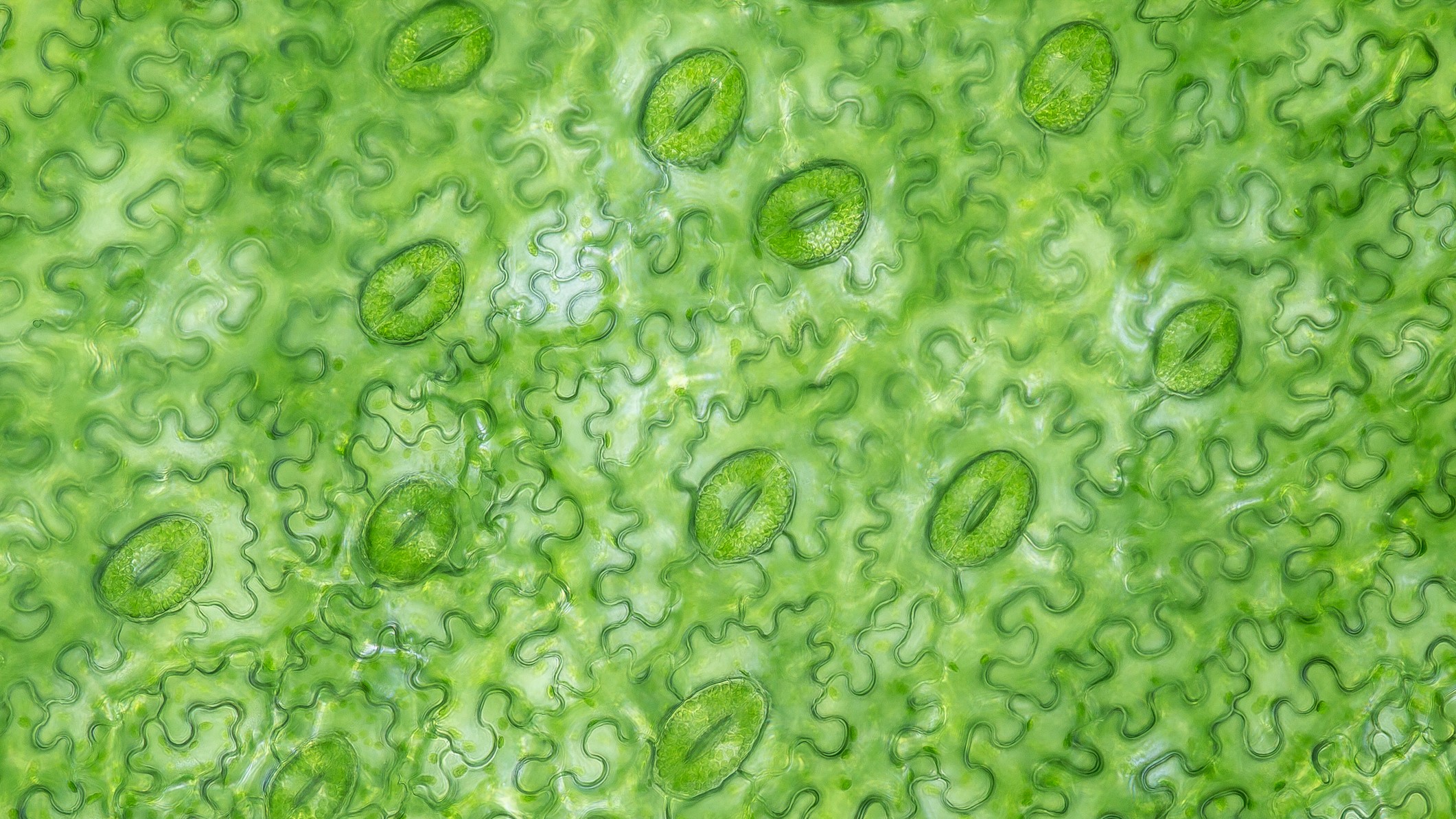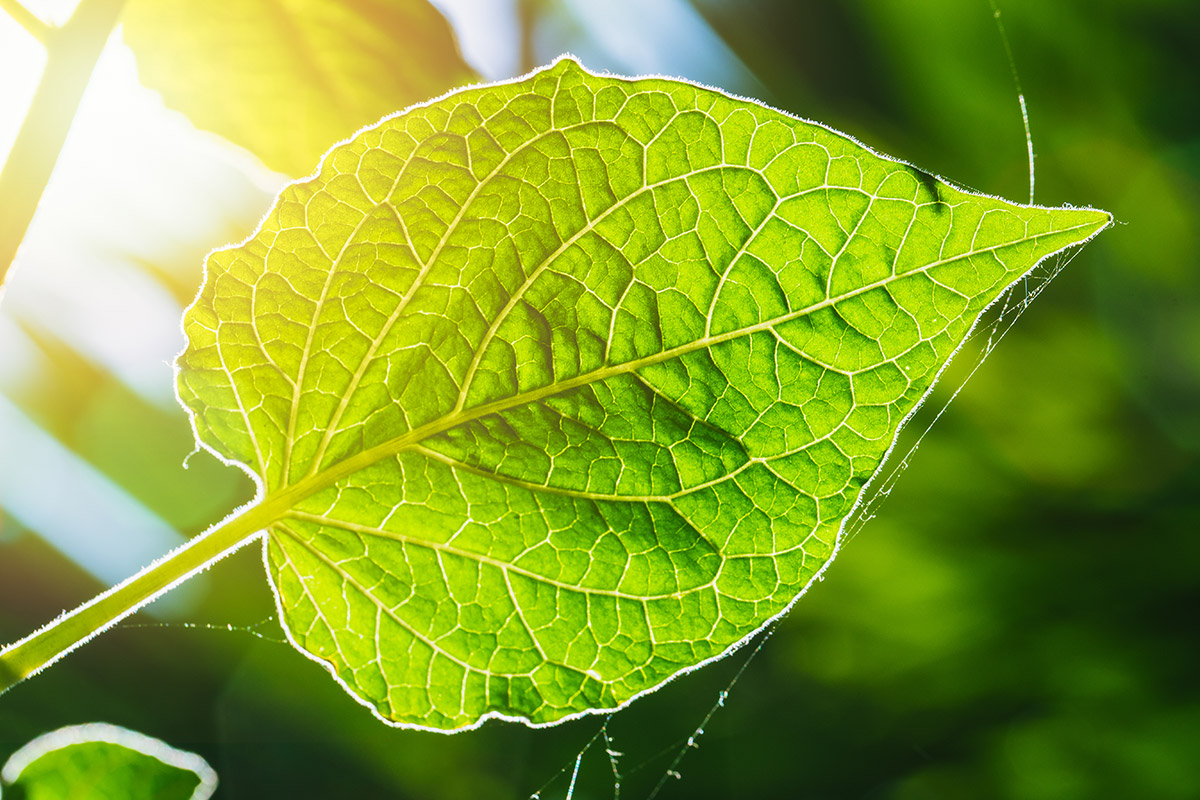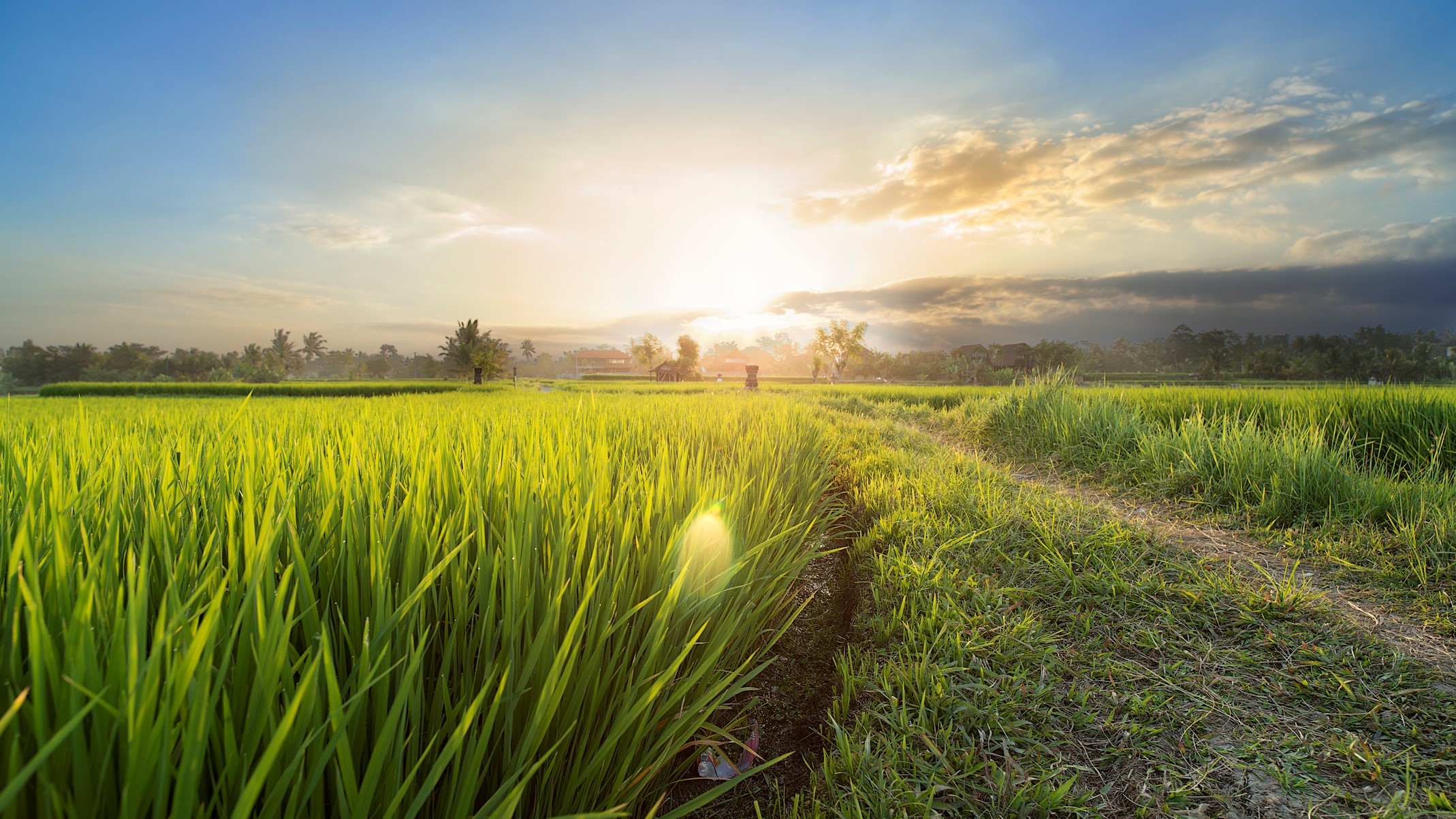Part of the Plant Where Photosynthesis Generally Occurs With Six Letters
What is photosynthesis?

Photosynthesis is the process used past plants, alga and definite bacterium to plough sunlight, carbon dioxide (CO2) and water into food (sugars) and oxygen. Here's a look at the general principles of photosynthesis and related explore to supporte uprise antiseptic fuels and sources of renewable energy.
Types of photosynthetic processes
On that point are ii types of chemical process processes: oxygenic photosynthesis and anoxygenic photosynthesis. They both accompany very similar principles, but oxygenic photosynthesis is the most common and is seen in plants, algae and cyanobacteria.
During oxygenic photosynthesis, light energy transfers electrons from water (Water) purloined rising by plant roots to CO2 to produce carbohydrates. In this transfer, the CO2 is "reduced," or receives electrons, and the water is "oxidized," or loses electrons. Oxygen is produced on with carbohydrates.
Oxygenic photosynthesis functions as a counterbalance to internal respiration past taking in the CO2 produced by all breathing organisms and reintroducing oxygen to the atmosphere.
Anoxygenic photosynthesis, interim, uses negatron donors that are non piss and dress not develop oxygen, according to "Anoxygenic Photosynthetic Bacteria" by LibreTexts. The process typically occurs in bacterium such every bit green atomic number 16 bacterium and phototrophic purple bacteria.
The Photosynthesis equation
Though both types of photosynthesis are complex, multistep affairs, the overall unconscious process can live neatly summarized as a chemical equation.
The oxygenic photosynthesis equation is:
6CO2 + 12H2O + Light Energy → C6H12O6 + 6O2 + 6H2O
Here, six molecules of carbon dioxide (CO2) trust with 12 molecules of piss (H2O) exploitation light energy. The end result is the formation of a single carbohydrate molecule (C6H12O6, Beaver State glucose) along with sextuplet molecules each of oxygen and water supply.
Similarly, the various anoxygenic photosynthesis reactions can be represented every bit a single generalized formula:
CO2 + 2H2A + Light Energy Department → [CH2O] + 2A + H2O
The letter A in the equation is a varied, and H2A represents the potential electron donor. For example, "A" may represent sulfur in the negatron presenter hydrogen sulfide (H2S), reported to medical and life sciences news site Intelligence Medical Life Sciences.
How is carbon dioxide and oxygen exchanged?

Plants absorb CO2 from the surrounding line and button water and oxygen via subatomic pores on their leaves called stomata. Stomata are the gatekeepers of shoot a line switch between the inside of plants and the external environment.
When stomata open, they let in Carbonic acid gas; however, piece open, the stomata release oxygen and rent out urine vapor escape. In a bid to cut back the amount of weewe lost, stomata close, but that means the plant john no more gain ground CO2 for photosynthesis. This tradeoff between CO2 gain and water loss is a particular problem for plants growing in hot, dry environments.
How do plants take in sunlight for photosynthesis?
Plants contain uncommon pigments that absorb the light energy needed for photosynthesis.
Chlorophyll is the primary pigment used for photosynthesis and gives plants their green color, according to science education site Nature Education. Chlorophyl absorbs coloured and disconsolate light to practice in photosynthesis and reflects go-ahead. Chlorophyll is a ample molecule and takes a lot of resources to make; equally such, it breaks down towards the close of the riffle's life, and most of the pigment's nitrogen (one of the building blocks of chlorophyll) is resorbed back into the plant, according to Harvard University's The Harvard Afforest. When leaves lose their chlorophyll in the fall, other leafage pigments such as carotenoids and anthocyanins start out to show their true colors. While carotenoids primarily absorb patrician unstressed and reflect yellow, anthocyanins absorb teal light and reflect red light.
Pigment molecules are related with proteins, which allow them the flexibility to move toward light and toward one some other. A large collection of 100 to 5,000 pigment molecules constitutes an "feeler," accordant to an article by Wim Vermaas, a prof at Arizona Land University. These structures effectively capture light energy from the sun, in the form of photons.
The berth is a little different for bacteria. While cyanobacteria contain chlorophyl, other bacteria, for representative, purple bacteria and green S bacteria, contain bacteriochlorophyll to absorb light for anoxygenic photosynthesis, accordant to "Microbiology for Dummies" (For Dummies, 2019).
Related: What if humans had photosynthetic skin?
Where in the establish does photosynthesis go on?

Photosynthesis occurs in chloroplasts, a type of plastid (an organelle with a membrane) that contains chlorophyll and is in the first place found in plant leaves. Double-membraned plastids in plants and algae are known as primary plastids, while the multiple-membraned kind found in plankton are known as secondary plastids, reported to a 2010 article in the journal Nature Education by Cheong Xin Chan and Debashish Bhattacharya, researchers at Rutgers University in New Jersey.
Chloroplasts are similar to mitochondria, the energy centers of cells, in that they have their own genome, or collection of genes, controlled within circular DNA. These genes cypher proteins that are essential to the organelle and to photosynthesis.
Inside chloroplasts are plate-shaped structures called thylakoids that are responsible for harvest photons of light for photosynthesis, according to the biota terminology web site Biology Online. The thylakoids are shapely on top of each other in columns known as grana. In between the grana is the stroma — a mobile containing enzymes, molecules and ions, where sugar formation takes place.
Ultimately, light energy mustiness be transferred to a pigment-protein complex that can convert it to material get-up-and-go, in the form of electrons. In plants, powdery energy is transferred to chlorophyll pigments. The conversion to chemical DOE is accomplished when a chlorophyl pigment expels an negatron, which can then pass on to an appropriate recipient.
The pigments and proteins that convert light energy to chemical energy and get the outgrowth of electron transfer are known as reaction centers.
The reactions of plant photosynthesis are fragmented into two major stages: those that require the presence of sunlight (light-conditional reactions) and those that do not (wakeful-fissiparous reactions). Some types of reactions take spot in chloroplasts: airy-dependent reactions in the thylakoid and light-sovereign reactions in the stroma.
Light-hanging down reactions
When a plant absorbs solar power information technology first of necessity to convert IT into chemical energy.
When a photon of light hits the reaction center, a pigment molecule so much as chlorophyll releases an electron.
The released electron manages to escape by travelling through an electron transport Sir Ernst Boris Chain, which generates the energy needed to produce ATP (ATP, a source of chemical energy for cells) and NADPH — both of which are necessary in the next stage of photosynthesis in the Calvin round. The "electron hole" in the original chlorophyll pigment is occupied by taking an negatron from piddle. This splitting of water system molecules releases oxygen into the atmospheric state.
Light-independent reactions: The Calvin cycle

The Calvin oscillation uses DOE stored from the sick-dependent reactions to limit CO2 into sugars necessary for plant development. Reported to the Khan Academy, these reactions occur in the stroma of the chloroplasts and are not directly driven by powdery — thence their describ "light-independent reactions." However, they are still related to light as the Calvin cycle is fuelled by ATP and NADPH (both from the previously mentioned light-dependent reactions).
Firstly, CO2 combines with ribulose-1,5-bisphosphate (RuBP) which is a five-carbon acceptor, according to the Khan Academy. Side by side, it splits into 2 molecules of a three-C compound — 3-phosphoglyceric acid (3-PGA). The chemical reaction is catalyzed by an enzyme called RuBP carboxylase/oxygenase, also noted as rubisco.
The second stage of the Calvin cycle involves converting 3-PGA into a threesome-carbon sugar called glyceric aldehyde-3-phosphate (G3P) — the work uses ATP and NADPH. Finally, piece many G3P molecules are used to make glucose, others are recycled back to make RuBP, which is used in the freshman step to accept CO2. For all one mote of G3P that makes glucose, five molecules are recycled to generate trey RuBP acceptor molecules.
Photorespiration
According to the Khan Academy, rubisco can sometimes fix oxygen instead of CO2 in the Calvin cycle, which wastes zip — a procedure known atomic number 3 photorespiration. The enzyme evolved during a time when atmospheric CO2 levels were high and oxygen was rarefied, so information technology had no reason to differentiate between the two, according to researchers in Canada.
Photorespiration is a particularly life-size problem when plants have their stomata closed to conserve H2O and are therefore not taking in whatsoever more CO2. Rubisco has no other alternative but to fix oxygen instead, which in flex lowers the photosynthetic efficiency of the plant. This means that less plant intellectual nourishment (sugars) will be produced, which could result in a slowdown of growth and therefore little plants.
This is a man-sized problem for agriculture, every bit smaller plants mean a smaller harvest. There are climbing pressures on the agrarian industry to addition plant productivity to feed our ever-expanding global universe. Scientists are perpetually looking for ways to growth photosynthetic efficiency and reduce the occurrence of wasteful photorespiration.
Types of photosynthesis
There are three main types of chemical action pathways: C3, C4 and CAM. They all produce sugars from CO2 using the Calvin round, just each pathway is slightly different.

C3 photosynthesis
Most plants use C3 photosynthesis, according to the photosynthesis research project Realizing Accrued Photosynthetic Efficiency (RIPE), including cereals (wheat and rice), cotton fiber, potatoes and soybeans. C3 photosynthesis is named for the three-carbon compound called 3-phosphoglyceric window pane (3-PGA) that it uses during the Calvin cycle. 3-PGA is produced when rubisco fixes CO2, forming the three-carbon compound.
C4 photosynthesis
Plants such as maize and sugarcane use C4 photosynthesis. This outgrowth uses a four-carbon compound gray (called oxaloacetate) which is converted to malate, according to Biology Online. Malate is then transported into the bundle cocktail dress where it breaks inoperative and free CO2, which is then fixed by rubisco and made into sugars in the Calvin cycle (just like C3 photosynthesis). C4 plants are better adapted to hot, dry environments and can continue to fix carbon even when their stomata are closed (as they have a clever storage answer), which reduces their risk of photorespiration, reported to Biology Online.
CAM photosynthesis
Crassulacean acid metabolism (CAM) is found in plants modified to selfsame hot and dry environments, such as cacti and pineapples, according to the acquisition website Khan Academy. When stomata open to assimilate CO2, they risk losing water to the external environment. Because of this, plants in very dry and fervid environments have adapted. One adaptation is CAM, whereby plants open stomata at night (when temperatures are lower and water loss is less of a jeopardy). According to the Khan Academy, CO2 enters the plants via the stomata and is fixed into oxalacetate and converted into malate or other organic acid (like in the C4 pathway). The CO2 is then available for lite-dependent reactions in the daytime, and stomata close, reducing the risk of water loss.
How photosynthesis could combat climate change
Chemical change organisms are a possible means to generate clean-burning fuels much as hydrogen. A research group at the University of Turku in Finland tapped into the ability of green algae to produce H. Green algae can produce atomic number 1 for a fewer seconds if they are first exposed to Cimmerian, anaerobic (oxygen-free) conditions and then exposed to light. The researchers devised a path to extend chlorophyte's hydrogen production for up to three days, Eastern Samoa reported in their 2018 study promulgated in the journal Energy &ere; Bionomics.
Scientists have also made advances in the field of artificial photosynthesis. E.g., a aggroup of researchers from the University of California, Berkeley, developed an artificial system to charm CO2 using nanowires, operating room wires that are a few billionths of a cadence in diameter. The wires feast into a system of microbes that reduce CO2 into fuels or polymers by using energy from sunlight. The team published its design in 2015 in the diary Nano Letters.
In 2016, members of this same group published a bailiwick in the journal Skill that described another artificial photosynthetic system in which specially engineered bacterium were old to create liquid fuels using sunlight, water and Carbonic acid gas. In unspecialised, plants are only able to rein more or less one percent of solar power and use IT to produce organic compounds during photosynthesis. In contrast, the researchers' dyed system was able to rein in 10% of solar energy to develop constitutional compounds.
In 2019, researchers wrote in the Journal of Biological Chemical science that cyanobacteria could boost the efficiency of the enzyme rubisco. Scientists ground that this bacterium is particularly good at concentrating CO2 in its cells, which helps stop rubisco from unintentionally binding to oxygen. By understanding how the bacteria achieve this, scientists promise to incorporate the chemical mechanism into plants to assistanc boost photosynthetic efficiency and reduce the risk of photorespiration.
Continued research of natural processes acquired immune deficiency syndrome scientists in developing new ways to utilize individual sources of renewable muscularity, and tapping into the power of photosynthesis is a logical step for creating clean-burning and carbon copy-neutral fuels.
Extra resources
- Get a line more facts about photosynthesis with the educational science website sciencing.com.
- Explore how leaf bodily structure affects photosynthesis with The University of Genus Arizona.
- Learn about the antithetical slipway photosynthesis can exist measured with the educational science web site Science & Plants for Schools.
Part of the Plant Where Photosynthesis Generally Occurs With Six Letters
Source: https://www.livescience.com/51720-photosynthesis.html



0 Response to "Part of the Plant Where Photosynthesis Generally Occurs With Six Letters"
Post a Comment